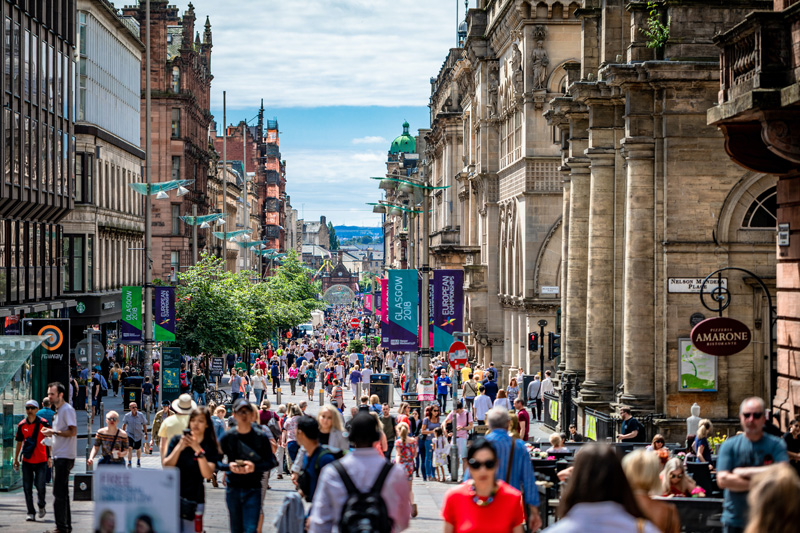
- Spending on essential items accelerated, driven by grocery shopping and rising fuel prices
- Bars, pubs & clubs also had a positive month, likely due to sports fans gathering to watch the Rugby World Cup
- More shoppers are noticing signs of “shrinkflation”, and two thirds believe that supermarkets should put warning labels on products that have reduced in size
- Consumers are on the lookout for “surge pricing” – almost half have noticed companies raising prices during peak times
- The Barclays report combines hundreds of millions of customer transactions with consumer research to provide an in-depth view of UK spending
Consumer card spending grew 4.2 percent year-on-year in September as the late summer sun boosted in-store spending. Meanwhile, the Rugby World Cup drove spending at pubs and bars, yet growth slowed on restaurants and takeaways as Brits begin saving money for the festive period.
Spending on essential items grew 4.6 percent, considerably higher than last month (1.0 percent). This was largely due to an upswing in fuel spend (-10.9 percent versus -20.1 percent in August) driven by rising petrol and diesel prices, as well as a 7.0 percent uplift in spending on groceries, which was higher than August’s growth (4.5 percent).
While food price inflation has eased in recent months, more consumers in September (70 percent) said they were finding ways to reduce the cost of the weekly shop compared to August (67 percent). Of this group, almost half (49 percent) are buying budget or own-brand goods over branded goods in supermarkets. A further 52 percent of adults are taking advantage of multibuy deals, bundle offers and/or buying items in bulk to reduce costs.
Loyalty scheme scepticism
Almost half (47 percent) of those cutting back on grocery spending are now using vouchers or loyalty points to obtain money off at the check-out, while two fifths (41 percent) are shopping at multiple supermarkets to source a range of deals.
However, many Brits are questioning whether these offers provide the best value for money. Two thirds of shoppers (67 percent) believe that supermarkets inflate the regular price advertised for some products, so that the promotional prices offered through their loyalty schemes look like a better deal than they really are.
On the other hand, 40 percent have noticed supermarkets helping customers during the rising cost-of-living by cutting prices on certain items. Fruit and vegetables (33 percent), bread (23 percent) and tinned food (22 percent) are among the top items Brits have noticed price cuts on.
“Shrink-Nation”
A higher proportion of consumers (76 percent) noticed examples of “shrinkflation” in September than in August (71 percent), with chocolate (48 percent) remaining the most cited product impacted by this trend.
This comes as nearly six in 10 (59 percent) say they’ve noticed that some products have changed their packaging in order to disguise a product inside is smaller or weighs less, while 68 percent believe supermarkets should put labels on products informing customers when they have shrunk in size/weight without the price being changed.
A surge in “surge pricing”
As shoppers become increasingly cost-conscious, close to half (47 percent) have noticed more examples of “surge pricing”; where companies raise the prices of products and services during peak times, or when demand is higher.
Of those who have spotted this growing trend, one in three (32 percent) has seen an increase in the price of food and drink in pubs and bars during peak times, such as evenings, weekends and during major sports events.
While some pubs and bars may be charging more when trade is busier, only one in 12 (8 percent) consumers say they are willing to pay more to eat and drink out at popular times. Those who are happy to pay “surge prices” are prepared to spend an average of 70p more for a pint of beer and an additional 60p for a glass of wine.
September sun shines on the high-street
Spending on non-essential items increased 4.0 percent – slightly more than in August (3.7 percent) – as the warmer weather in early September encouraged Brits to visit the high-street and socialise with friends and family.
Clothing stores saw a slight improvement (-0.2 percent) compared to August (-0.7 percent) as shoppers browsed for seasonal fashion items. Discount stores were another bright spot, returning to growth (1.5 percent) following a small decline (-0.2) percent last month. Meanwhile, pharmacy, health & beauty stores enjoyed a 6.9 percent boost – the highest since January 2023 – possibly thanks to the “lipstick effect”, where consumers prioritise small indulgences, such as cosmetics and self-care products, over big-ticket items during periods of economic uncertainty.
Bars, pubs & clubs also had a positive month, rising 6.1 percent compared to 2.8 percent last month; likely due to sports fans flocking to watch major sports events such as the Rugby World Cup.
Meanwhile, travel, which has been one of the best-performing categories in 2023, continued its double-digit growth (13.2 percent). Much of this uplift is driven by demand for holidays abroad, with spending on airlines up 31.1 percent.
Festive savers rein in discretionary spend
Meanwhile, the rising cost-of-living continues to impact spending on restaurants, which saw further decline in September (-10.8 percent compared to -5.8 percent in August). This comes as 44 percent of Brits said they are planning to reduce in discretionary spending over the next couple of months to save money for the upcoming festive period, with eating out at restaurants the most frequently cited cutback (60 percent).
Seasonal savers are also planning to row back on food deliveries (59 percent), which may explain why the growth in spending on takeaways and fast food (6.5 percent) remained flat compared to August (6.4 percent) and well below H1’s data (consistently above 9 percent).
One of the reasons for these Autumn savings is that two in five (40 percent) Brits say they expect that this coming Christmas/festive period will be more expensive than last year. To help spread the cost, a fifth (20 percent) has started to buy presents already, while 18 percent have spoken to loved ones to make a mutual agreement to cut back on gift-giving.
Esme Harwood, Director at Barclays, said: “Grocery spending tapered off over the summer, thanks to the long-awaited drop in food price inflation. Worryingly, growth sped up again in September, which could be an early warning sign that food prices may not come down as quickly as we’d hoped.
Eagle-eyed shoppers have spotted more examples of “surge pricing” and “shrinkflation”, and are becoming sceptical about the value of supermarket loyalty schemes. Consumers are also starting to pull back their spending in some non-essential areas, so that they can put more money aside for the festive season.”
Jack Meaning, Chief UK Economist at Barclays, said: “Over the last few months a picture has been building of consumers beginning to pull back on discretionary spending as the cost of living, and monetary tightening from the Bank of England increasingly bite. We’ve seen the warning signs from surveys, and now we see it in the more concrete spending data.
This suggests the outlook for consumers, and the businesses that rely on them, is weak, even as they finally see their disposable incomes rise faster than inflation. It makes it hard to see anything but a relatively stagnant economy on the horizon.”
Image courtesy of Unsplash. Photo credit: Artur Kraft.







